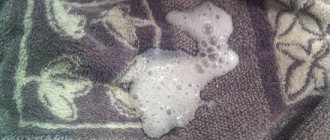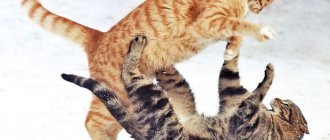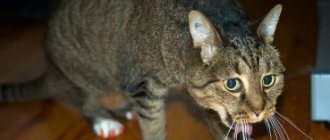Why does a cat vomit white foam?
The gag reflex in representatives of the cat family is often a protective reaction to the ingress of a foreign object, irritating substances or pathogenic bacteria. In such cases there is no cause for concern. It’s another matter when vomiting is a sign of a serious pathology that requires immediate treatment. It is almost impossible to independently determine what exactly caused the regurgitation of foamy liquid, so consulting a veterinarian will never be superfluous. The most common causes of vomiting:
- The most dangerous diseases are panleukopenia and feline distemper. In advanced cases, they can be fatal. Vomiting with white or yellowish foam, in which there are no food particles, occurs frequently, without bringing relief to the animal.
- An infectious respiratory disease when vomiting is accompanied by coughing, and a small amount of blood is present in the regurgitated foam.
- Inflammatory processes in the gastrointestinal tract. The most harmless pathology among them is heartburn. Symptoms occur immediately after feeding. Enteritis is a deadly disease when a cat's vomiting of white foam is accompanied by prolonged diarrhea.
- Inflammation of the adrenal glands. Muscle weakness is noted, the animal becomes lethargic, and the sugar level decreases. Without immediate assistance, the cat may die.
- Poor diet is one of the most common causes of vomiting. When you overeat, your body begins to resist the large amount of food you eat. High sensitivity in cats is also observed when there is a lack of food. Foamy vomiting occurs if the animal is not fed for a long time, which leads to the accumulation of hydrochloric acid, which irritates the stomach walls. A starvation diet for a cat should not last more than a day.
- Accumulation of hair in the stomach. This problem is especially relevant for long-haired breeds. When licking, the fur is swallowed inside, forming into dense clumps. Their irritation of the gastric mucosa causes the cat to vomit white foam.
- Worms and other parasites. Toxins formed during their life processes do not have time to be processed. The body responds to intoxication by vomiting, trying to get rid of harmful substances.
- Poisoning. Occurs as a result of the action of medications, household chemicals, poisonous insect bites, and accidental eating of poisonous grass.
A single vomiting with a small amount of foam is not a reason to panic. It is recommended to observe your pet for 24 hours - signs of discomfort may disappear the next day. If the situation worsens, the cat looks sick, there is no appetite, a visit to the doctor is not postponed.
Vomiting food and liquid
Once you know why your cat vomits white foam, you should also understand why this animal can sometimes vomit food and liquid. Typically, this behavior indicates a pathological change in the gastrointestinal tract. In addition, a cat may vomit food even in the case of banal overeating, since these animals have no sense of proportion and can eat gourmet foods in excessive quantities.
But in the case when blood appears in the vomit, it makes sense to be alarmed. The fact is that this may indicate that an infection has entered the animal’s body, or that it has worms. In this case, a visit to the veterinarian is mandatory for preventive purposes in order to prevent infection of both other animals and people.
Yellowish vomit is a sign of feline distemper
In addition, vomiting blood can also be a sign that a foreign object has entered the cat's stomach. Pets often lick and swallow various shiny and unknown objects that can be dangerous. So, very often they swallow glass or can damage their internal organs with bones. As a result, internal bleeding begins, which can threaten the life of the animal. Therefore, if you notice blood in the vomit, immediately take your pet to a veterinary clinic.
Vomiting liquid alone is also a cause for concern. The fact is that vomit, consisting of a yellowish liquid, is a sign of feline distemper. At the same time, the animal does not eat, is afraid of light, and its vomiting is strong and painful. If treatment measures are not taken in time, it can die quite quickly, primarily from dehydration.
You should be especially concerned when your cat begins to refuse food. Normally, even a sick animal eats periodically. If it stops doing this, it has a very serious condition. So, the means at hand most likely will not help him, and he will need to go to the nearest veterinary clinic.
If your cat is vomiting blood, it may have worms.
By the way, you should never forget about such an unpleasant subject as helminths.
Attention! Many cat owners, having noticed their vomiting and poor appetite, immediately begin to panic and completely forget that common worms can cause symptoms in animals that are similar to signs of dangerous illnesses.
Therefore, be sure to periodically inspect your animals for worms, because even domestic cats can pick them up by sitting, for example, for a short time in a tray with sand taken from the street.
First aid
What should you do if your cat is vomiting white foam, but there are no obvious symptoms indicating a serious illness? When your pet’s condition does not cause concern, and you cannot get to the nearest veterinary clinic, you can try to help him with a daily starvation diet. During this time, the digestive system is unloaded, due to which the damaged organ is restored. The next day, when the condition stabilizes and the vomiting stops, you can gradually give rice cooked in chicken broth. The cat must be fed frequently (up to six times a day), but in small portions. Every day the volume of food is increased, while simultaneously reducing the number of feedings.
For common stomach upset, mint decoction is effective. After brewing and cooling it to 37⁰C, pour one tablespoon into the cat’s mouth immediately after vomiting.
If there is a suspicion of accumulation of hairballs in the pet's intestines, the cat is given a teaspoon of oil 3 times a week, adding it to the food. It has a laxative effect, which leads to the cessation of vomiting.
Necessary treatment
When a cat vomits yellow liquid mixed with foam, you should not ignore this phenomenon. If the animal burps once, then therapy can be carried out at home. In advanced cases, treatment is selected by a veterinarian. It is important for the specialist to first clarify the patient’s nutritional characteristics and the presence/absence of vaccinations. To find out the reason why the cat vomited, laboratory and instrumental examinations are prescribed.
If an animal has food poisoning, you can give it Enetrosgel.
When the problem is caused by drug or food poisoning, you need to give the animal activated charcoal or Enterosgel. If a sick cat is not eating, you should not try to force feed it. It is recommended to refrain from eating for several hours, or even days, so as not to provoke vomiting again. When a cat vomits white foam, the following veterinary medications are used, listed in the table.
| Drug group | Name |
| Solution for restoring water balance | "Regidron" |
| "Atoxil" | |
| Antiemetics | "Torekan" |
| "Paspertine" | |
| "Phenothiazine" | |
| Medicines for intramuscular injections | "Cerucal" |
Veterinarians recommend taking antibiotics and sulfa drugs for prolonged and severe vomiting with foam associated with gastrointestinal pathologies. If severe intoxication is detected, then the disorder must be treated with intravenous glucose.
When to see a doctor
If vomiting occurs repeatedly, you should not postpone a visit to the veterinarian. In addition, there are a number of accompanying signs indicating the need for urgent medical attention:
- The cat has no interest in food. Together with foamy vomiting, this is a very alarming symptom, raising suspicion of liver lipidosis.
- Intense thirst. When an animal does not move away from a cup of water, there is a high probability of kidney pathology.
- The cat does not urinate for a long time, although he drinks a lot.
- Vomiting occurs very often - up to several times in one hour.
If you notice signs of illness in your cat, you should not wait for a miracle or self-medicate. Vomiting that continues for more than a day can cause dehydration, which poses a serious threat to the pet’s life. Timely professional assistance will help alleviate the animal’s condition and prevent its death.
Natural Causes of White Vomit
The cat vomits foam with saliva during protective reactions of the body associated with:
- with trichobezoars - accumulation of hairballs in the stomach, which the animal absorbs while licking and regurgitates to release it;
- foreign bodies - in transparent vomit you can find an object eaten by a cat;
- eating grass or indoor plants - the plants irritate the stomach, the pet burps them and begins to diarrhea;
- stress - nervous overstrain leads to the fact that the pet can vomit;
- estrus and sexual heat - loss of appetite, increased anxiety triggers protective mechanisms;
- motion sickness - travel in transport is a common source of illness in pets.
If a cat vomits, this does not always indicate some kind of disease.
Important! The physiological phenomenon does not cause additional symptoms, the cat continues to move actively and eat calmly.
It occurs 1-2 times and goes away on its own.
Diagnosis and treatment
First of all, the doctor determines the reason that caused the cat to vomit. To do this, the owner must be prepared to answer a number of questions to help diagnose the pathology:
- Cat's diet. What did they feed him in recent days, were there any changes in his diet?
- When did the vomiting start and how often did it occur?
- Composition and quantity of vomit. The release of abundant white foam may indicate problems with bile secretion.
- Does the cat have an appetite?
- The presence of chronic or infectious diseases.
An analysis of the general condition of the animal is carried out. If symptoms are detected that raise suspicion of serious, dangerous pathologies, a blood and urine test is performed. An ultrasound examination of the abdominal cavity and an x-ray of the kidneys may be prescribed. Depending on the disease, a treatment regimen is selected, including medications and measures aimed at preventing dehydration. Vomiting of white foam in a cat, associated with impaired bile secretion, requires adherence to a diet and the use of special medications to help restore the process.
It is better to immediately take your pet to the veterinarian at the first signs of discomfort. Measures taken on time increase the chances of a speedy recovery, helping to restore the cat to its former activity and good mood.
What influences the problem?
Natural causes
Yellow foamy vomit should not always cause alarm among owners, since it is a consequence of physiological processes. If the pet does not burp repeatedly, and its health does not deteriorate, then this may be a consequence of temporary disturbances. Often a cat vomits water and foam in the following cases:
- Hairballs. These are clean animals that constantly lick themselves, which is why they often have hairballs in their stomachs, which they vomit, although the presence of clear liquid or white foam is acceptable.
- Consumption of dry food. The causes of vomiting are the strong swelling of such a food product in the stomach, and after a while the cat regurgitates the remains.
- Desire to eat. The appearance of vomiting in a cat is associated with hydrochloric acid, which irritates the gastrointestinal mucosa.
- A large meal. Some pets do not feel full and eat more than necessary, which causes the cat to vomit the remains of undigested food mixed with foam.
- Entry of a foreign body. Foamy saliva and vomiting are the result of a foreign object getting into the throat, which the cat is trying to get rid of.
- Estrus. During this period, the behavior of cats and cats may differ, and at the estrus stage, nausea and vomiting with foam are possible.
- Taking medications. An unpleasant symptom manifests itself as an adverse reaction or during long-term treatment with drugs.
- Severe stress. An imbalance in the psycho-emotional state negatively affects the animal, which is why sometimes the cat vomits yellow liquid.
During pregnancy, animals may also experience early toxicosis. Such foamy vomiting should not cause alarm if it does not affect the general condition of the cat.
Pathological factors
If the symptom appears several times, then the pet probably has helminths.
Repeated vomiting of white foam in a cat is not normal and requires contacting a veterinarian. If your pet regularly burps, regardless of food intake, this may indicate illness and other pathological conditions, such as:
- Helminthic infection. The cat's body is prone to the appearance of various small parasites, which is why the cat can vomit a worm. If there is a deviation, itching in the anus, diarrhea and other symptoms are recorded.
- Deviations from the digestive tract. When an adult or kitten vomits bile, this indicates damage to the gastrointestinal tract. The vomit contains foam and blood. In most cases, the problem is associated with an ulcer, gastritis, enteritis or pancreatitis.
- Viral infections. Particular dangers for cats are herpes, rabies, immunodeficiency, and panleukopenia. If you do not notice the manifestations of diarrhea, vomiting white foam and other signs in time, then the rapid death of your pet is possible.
- Vaccination. Often, after the vaccine is administered, a kitten or adult will experience nausea and a gag reflex with clear liquid. This condition disappears after 3 days.
- Surgical intervention. Unpleasant consequences are often observed after removing a cat from anesthesia.
First aid for an animal
Supportive measures depend on the root causes of deterioration in health:
- in case of poisoning - activated carbon is crushed, dissolved and given to the pet using a syringe (1 tablet per 10 kg of weight);
- in case of paroxysmal short-term vomiting, balance is restored with rehydron solution;
- a weakened pet is supported with injections of ringer's solution, atoxil and enterosgel.
Important! If such a condition in a cat continues for more than 48 hours, then it must be taken to the veterinarian. Further self-medication can lead to the death of the animal.
In any critical situation, it is better to show the animal to a veterinarian
Treatment at home and at the veterinarian
If you notice unusual vomiting in your pet, you should try to help even before you get to the veterinary clinic. It is important to create a comfortable environment at home. Never scold your pet for exhibiting uncontrollable physiological reactions! Carefully monitor the cat, note in a notebook all unusual phenomena and accompanying symptoms - the veterinarian will definitely ask about them.
The bowl should contain clean filtered water at room temperature, but it is better to remove food for a while - especially if you suspect some kind of disease. Protect your pet from the harassment of children and other animals. Prepare a comfortable carrier and a warm blanket for transportation to the clinic (if it’s cold outside).
First aid at home
The very first action is to limit your pet's food intake, unless it is a case of hunger nausea. You should not give food for a day - this will reduce the load on the body. Be sure to carefully examine the vomit to accurately describe everything to the doctor. Ideally, take a photo of them. Observe whether there are accompanying alarming factors: whether the cat behaves restlessly, whether saliva flows, whether complaining sounds are heard, etc.
If your cat is vomiting from hunger, offer him a very small amount of boiled diet food - chicken or beef broth, a little wet food. Start with one tablespoon of food, then gradually, over two days, increase the portion to the usual one. At this time, the interval between feedings should be minimal - up to 3 hours.
During a fasting diet, water should be freely available. You should only use bottled or filtered liquid - tap water will only cause more harm. If the condition stabilizes, then you can give a little boiled rice.
If nausea continues, administer first aid to prevent dehydration. Most likely, the veterinarian will recommend the following over the phone:
- Give the cat activated carbon in a ratio of 1:10, that is, a tablet per ten kilos of weight. Observe all proportions strictly. Dilute the tablet in water and inject it into the mouth from a large syringe, after removing the needle. This will help if nausea occurs due to poisoning.
- If the attacks are short-lived, then you can give the furry patient Regidron solution.
- Dehydration can be prevented with the help of medications Enterosgel and Atoxil - but the dosage should be checked with a veterinarian by phone.
- If the cat is very weak and does not want to take liquid, then you need to inject Ringer's solution.
- If you suspect that the animal has eaten a small object, then you need to provoke a gag reflex. You can prepare a saline solution: to do this, mix one tablespoon of salt in 1 glass of warm water. Give your pet a drink until the urge to feel sick appears.
If the animal’s health does not stabilize within a couple of days, then you should immediately take it to a veterinary clinic.
Going to the veterinary clinic
Treatment for a cat vomiting white foam begins with an examination at a veterinary hospital. Tell the doctor all the information about your pet and its condition, when you began to notice such phenomena, and whether there are any chronic diseases. To make a correct diagnosis, you will need a thorough examination of the animal, laboratory tests, ultrasound of the abdominal cavity and kidneys. Based on the results, the veterinarian will establish a treatment regimen: it usually includes drug therapy and the parallel elimination and prevention of dehydration.
It is impossible to say in advance what medications the veterinarian will prescribe - it all depends on the primary disease. Infectious diseases will require a course of antiviral and antibiotics along with immunostimulating therapy. In case of poisoning, it is necessary to administer an antidote and detoxify the body. If there are problems in the gastrointestinal tract, the problematic organ is identified and treated.
Don't forget about the special diet. Food should be semi-liquid. It is best to feed small and frequent meals. If you give meat, it must first be boiled and chopped. After everything has stabilized, you can gradually switch to normal nutrition.
Vomiting foam in kittens
Kittens have a weak digestive system, so vomiting can occur quite often. The main reasons for this condition look like this:
- Sudden change in diet. For example, a kitten was separated from its mother and transferred to adult food, while its small stomach is not yet able to digest roughage.
- Harmful foods - fried, smoked, spicy or simply stale - can cause vomiting in the baby.
- Persistent overeating or large pieces of food - compassionate owners try to feed their pet more satisfyingly; it seems to them that the kitten is too thin. This will not lead to anything good.
- If the kitten licks itself often, then vomiting may be a consequence of the accumulation of hair in the ventricle. This is especially true for animals with long-haired breeds.
- Accidental entry of foreign objects into the stomach. While playing, the kitten may swallow a candy wrapper, a bead, or a piece of tinsel.
- Chemical poisoning – like all babies, kittens are very curious, so they may try dishwashing liquid or litter.
- Side effects after vaccination are how the body reacts to a foreign agent entering the body.
- Congenital diseases of the liver or pancreas.
If the baby vomits, it is necessary to find out the cause of this phenomenon and eliminate it. If this condition is rarely observed, then you can observe the kitten and try to adjust the diet. When liquid, foamy vomiting is observed frequently, you need to go to a veterinary hospital .
A healthy kitten should be active and have a good appetite. If the baby is lethargic, refuses to play and eats poorly, then this is a reason to visit the doctor.
How to help a cat when vomiting
You can help your cat on your own, but only if there is no high fever, diarrhea or general weakness. When such a malaise indicates poisoning, the algorithm of actions should be as follows:
- The animal is stopped fed and provided with a sufficient amount of drink . Only water can be given; dairy products are not recommended during this period.
- The cat is given a weak solution of potassium permanganate; it can be added to drinking water or poured into the mouth from a syringe with a soft tip.
Manganese is first diluted in a small volume of water, and then added to the drink, and poured through several layers of gauze to prevent undissolved crystals from entering the stomach.
- Every two hours, the pet is given smecta dissolved in a small volume of water.
Therapeutic fasting for cats should last about 12 hours. After this, you can gradually return the cat to its normal diet. First, they adhere to a gentle diet and give boiled chicken meat, as well as strong rice water, then chicken broth or special medicinal food is introduced. After 3-4 days, the cat is transferred to standard food. Usually such actions are enough for the pet to recover and return to a full life.
Vomiting in a pregnant cat
The cat is vomiting bile and doesn’t eat anything: what to do?
Toxicosis in a cat is a normal physiological phenomenon. Sharp changes in hormonal balance associated with conception and subsequent development of the fetus cause attacks in the first weeks of gestation. In the last stages of pregnancy, the appearance of white foam in the vomit indicates the maximum volume of the uterus and its pressure on the digestive organs.
Note! The physiological phenomenon in the cat does not affect the appetite and general condition. The animal feels good and behaves adequately.











